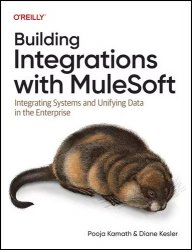Building Integrations with Mulesoft: Integrating Systems and Unifying Data in the Enterprise (Final Release)
- Добавил: literator
- Дата: Сегодня, 00:12
- Комментариев: 0
 Название: Building Integrations with Mulesoft: Integrating Systems and Unifying Data in the Enterprise (Final Release)
Название: Building Integrations with Mulesoft: Integrating Systems and Unifying Data in the Enterprise (Final Release)Автор: Pooja Kamath, Diane Kesler
Издательство: O’Reilly Media, Inc.
Год: 2025
Страниц: 393
Язык: английский
Формат: epub
Размер: 12.98 MB
Is your organization planning to adopt automation in the near future? This concise yet comprehensive guide shows developers and architects how to effectively tackle data integration challenges with MuleSoft. Authors Pooja Kamath and Diane Kesler guide you through the process necessary to build robust and scalable integration solutions.
Supported by real-world use cases, Building Integrations with MuleSoft teaches you effective ways to identify and resolve performance bottlenecks, handle errors, and ensure the reliability and scalability of your integration solutions. You'll also explore MuleSoft's robust set of connectors, their components, and how to use them to connect to a wide range of systems and applications, from legacy systems and databases to cloud services.
The goal of this book is to give you a linear coverage of what is required to get up and running and launch an API to production. We understand that software development is an iterative process, and in the real world you will have to bounce back and forth between processes for the successful delivery of applications. MuleSoft is a very big topic with a lot of products; we won’t be able to cover it all. With the help of a use case, we will learn how to create an API, develop, test, and deploy it. We won’t be covering topics related to the broader topic of API management. Things like API Gateways, portals, monitoring, and overall governance are out of scope for us in this book.
At its core, an application programming interface (API) is like an agreement between systems, defining exactly how they will work together. With clear rules for inputs, outputs, and data types, each connection is efficient, consistent, and ready to play well with others, as you will see in Chapter 2. And while there are a few different flavors of APIs, RESTful APIs have taken the spotlight. They’re reliable, and easy to implement, and their structured methods keep development smooth and reusable, promoting self-service and rapid adoption.
MuleSoft takes API-led connectivity to another level by introducing a separation of concerns that makes integration downright organized. Instead of packing everything into one massive integration layer, as P2P did, MuleSoft breaks functionality into three distinct API layers: Experience APIs (EAPIs), Process APIs (PAPIs), and System APIs (SAPIs). Each layer is like its own team with a specific role:
EAPIs - Connect with end users and devices such as mobile apps or web servers
PAPIs - Handle data transformations and business logic in the background
SAPIs - Provide access to core systems such as databases or legacy platforms
Document the API so users know what resource endpoints, request/response formats, and authentication methods to use, and provide usage examples to assist developers in effectively utilizing the API. To design and document REST APIs, you can utilize API specification languages. A variety of popular languages are available, such as OAS, RAML, API Blueprint, and GraphQL Schema Definition Language (SDL). The next sections will explore OpenAPI Specification (OAS) and REST. However, for the remainder of this book, REST will be our preferred language for design and development.
RAML is a language used to describe RESTful APIs. It has a concise syntax, supports data types, security definitions, and resource hierarchies, and allows easy generation of API documentation. API documentation can be generated easily from RAML files with the use of tools such as api-console or raml2html. RAML files can be used by API Gateways like MuleSoft Anypoint Platform or Apigee to configure routing, security, and transformations. All of these features make RAML a better fit for creating APIs to build application networks when compared to other API modeling languages. RAML syntax is based on YAML and JSON, which makes it lightweight and human-readable. The syntax uses indentation to specify data hierarchy.
With this book, you'll learn:
Use case understanding: Ask the right questions, define requirements, decide on reuse versus rebuild, and create sequence and context diagrams
Tools: Master Anypoint Platform, Anypoint Studio, Code Builder, GitHub, and Maven
Prototyping: Design APIs with RAML and OAS, and craft effective requests and responses
Securing APIs: Apply Mule OAuth2.0 and understand security requirements
Testing: Write MUnit tests, validate DataWeave expressions, and use Postman Collections
Deploying: Understand CI/CD processes using Maven and deploy to CloudHub
Message orchestration: Learn techniques for routers, transactions, error handling, For Each, Parallel For Each, and batch processing
Who Should Use This Book?
This book is for developers and architects looking to get up to speed on developing integrations using MuleSoft. Most of the content used here is from the training material we have created and used over the years. This book also contains our learnings from past project experiences. This book can also serve as a comprehensive reference guide for fundamental topics such as API design methods, the API build process, testing, and other stages of API development using MuleSoft. This is why it is a valuable resource for senior software architects and API product managers who aim to provide consistent guidance to their teams.
Contents:
Скачать Building Integrations with Mulesoft: Integrating Systems and Unifying Data in the Enterprise (Final Release)
Внимание
Уважаемый посетитель, Вы зашли на сайт как незарегистрированный пользователь.
Мы рекомендуем Вам зарегистрироваться либо войти на сайт под своим именем.
Уважаемый посетитель, Вы зашли на сайт как незарегистрированный пользователь.
Мы рекомендуем Вам зарегистрироваться либо войти на сайт под своим именем.
Информация
Посетители, находящиеся в группе Гости, не могут оставлять комментарии к данной публикации.
Посетители, находящиеся в группе Гости, не могут оставлять комментарии к данной публикации.

